Also: Fixed Wing Aircraft Surveillance Cams; Safe Work Zone Ordinance at Council; 1st Q Projections Show Oakland Under Water, Lower Revenue, OPD-Driven Expenditure Overage; OPD Has Same Number of Cops After Academy Graduation as Before it Started
Registrar Reveals Recall Election Could Cost $20 MM as Price Contests Signature Collection by Non-Registered Voters
An Alameda County [ALCO] ballot measure that would sync Alameda County’s recall process with state law passed a final vote of the ALCO Board of Supervisors last Tuesday. The ballot measure heads to the March 5th ballot after a long, winding road at BOS. But in keeping with what has now become a regular series of difficult discussions at BOS, supervisors grappled with the compound problems that continue to dog the County’s current recall process.
Price Lawyer Opposes Waiving of Registered Voter Requirement for Signature Gatherers
James Sutton, a prominent election lawyer representing ALCO DA Pamela Price sent a letter to the board last Monday questioning decisions made by Registrar of Voters [ROV] Tim Dupuis as he creates a viable recall from a patchwork of constitutionally-valid local and state law.
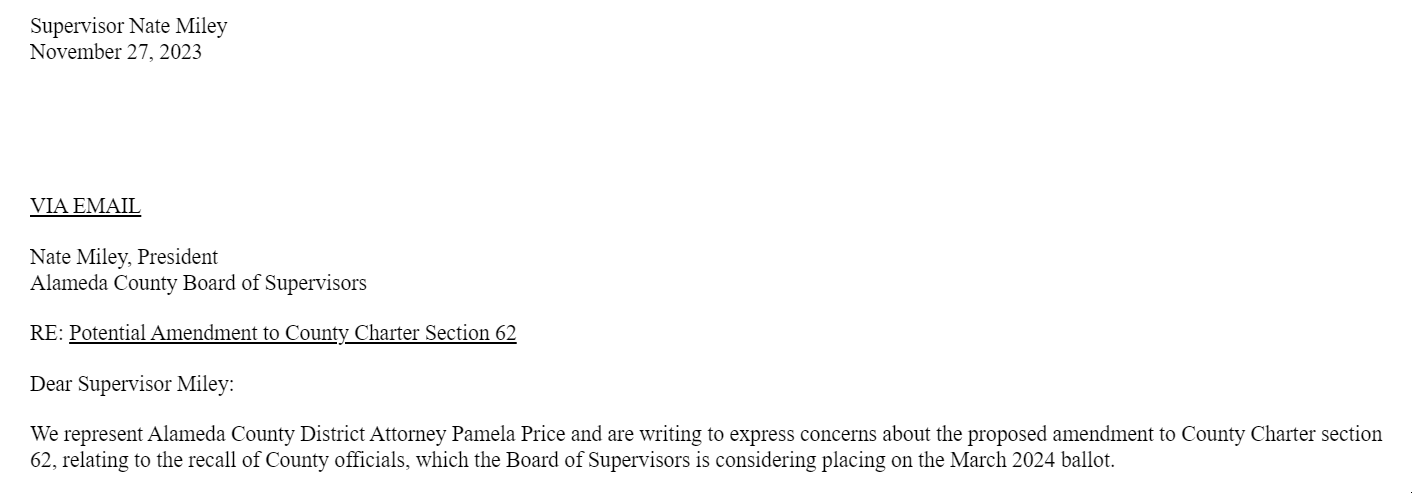
Sutton argues in the letter that Dupuis went too far in waiving the County’s current rule that requires signature gatherers to be registered ALCO voters. The Supreme Court opinion on the constitutionality of signature gatherer-status focused on legislative ballot measures, not recalls, and thus, the letter argues, recalls would be a separate area of judicial review. Sutton says Dupuis is applying a legal standard without case-specific merit:
“Initiative and referendum are concerned solely with legislative issues, not elected officials or candidates for public office, so these different types of campaigns raise very different legal and policy issues. Despite County Counsel’s advice and despite this Supreme Court case, it is not certain that a court would invalidate a registration requirement for individuals who are circulating recall petitions.”
Sutton goes on to argue that even if recall signature gathering were categorically included generally in the judicial decision, the ALCO charter’s recall rules would still require specific review, because the California constitution only allows an entity to ignore a law if it’s instructed to do so by a court:
“Regardless of the Supreme Court case and whether or not it applies to Charter section 62, the County does not have the authority to ignore this law unless instructed to do so by a court. The California Constitution is clear that local agencies, including the Alameda County Registrar of Voters’ office, must follow all laws unless and until the law has been invalidated by an appellate court”
Sutton's letter notes that Price had raised the issue with the ROV before the ROV had presented its process waiving the voter registration requirement. The letter suggests Price may sue over the issue:
In sum, because the County must follow County law until instructed by an appellate court to do otherwise, the Registrar’s office must reject any and all recall petitions which were circulated by anyone other than County voters, regardless of the proposed amendment to section 62. If the Registrar’s office does otherwise, District Attorney Price may be compelled to pursue all legal options to enforce this County law.
BOS Question Signature Gathering Rule, but Get Few Answers
During the discussion supervisors mostly reiterated their positions on the ballot measure in prelude to the second vote, but the introduction of the signature gatherer issue added a new dimension that supervisors discussed soberly with Counsel Donna Ziegler and ROV Dupuis.
Even if the recall ballot measure passes in March, it will not affect the preliminary process, signature collection or validation for the Price recall effort, and likely will only affect the scheduling of an election should SAFE, the Price recall committee founded by Brenda Grisham, Philip Dreyfuss and Carl Chan, collect enough signatures to trigger a recall. But the potential for lawsuits focused solely on the charter processes followed or ignored by the ROV in the process of signature gathering and validation remains a big concern for the BOS and County.
Some members of SAFE who spoke at the meeting appeared concerned about the potential of having signatures invalidated. SAFE has spent thousands on third-party signature gathering firms, but anecdotal evidence suggest many workers may not be ALCO residents or registered voters.
SAFE’s co-founder and current Assistant Treasurer Chan asked the board to fast-track a judicial review of the charter’s dictates on signature gatherers.
“...hopefully the BOS can place an item on the next agenda to seek judicial review of the Charter section 62 to clarify that the state law overrules the current charter for signature gathering,” Chan told supervisors.
When Supervisor Nate Miley redirected Chan’s question to Counsel Ziegler during the legislative discussion, Ziegler responded that the County itself would not be able to pre-empt the issue with a request for judicial review from the courts.
“The courts do not allow parties to just say, ‘we’re confused so we want to file a lawsuit and have the courts tell us’…what courts look for is a real case in controversy, there needs to be an opponent. Who would we sue if we tried to file an action in court? We don't have anyone to sue," Ziegler said.
Dupuis Says An Unscheduled Recall Election Could Cost $15-20 MM
Regardless, under the current rules as well, both Ziegler and Dupuis have noted that the ROV will likely fail to meet the short 10 day window to validate signatures under the current charter rules. That could also provoke lawsuits. When the question of the potential to have the recall by March 5th came up, Ziegler reiterated her concern that the ROV would not be able to meet the charter-mandated ten-day timeline for validation of the signatures.
Dupuis skirted the issue of the 10-day signature validation mandated in the charter should the signatures come in at a date before March 5th. But Dupuis revealed that should successful signature gathering result in an independent election on a date other than an already scheduled election—a very likely outcome given the few options in either state or county timeline—the election will cost taxpayers $15 to 20 MM in the staff, printing and mailing of ballots and other expenses which are currently not budgeted.
Here is Tim Dupuis, the ALCO Registrar of Voters, telling Supes on the record today that the District Attorney recall sought by SAFE will cost $15-20 MM if it happens as an independent election--an independent election is the most likely outcome if there's a recall. pic.twitter.com/mdcTsvdkLU
— Trash Night Heron (@hyphy_republic) November 29, 2023
“If it is an independent election, our posted rates for an election such as that, could be anywhere from $15 to $20 MM dollars for a county election…that is really when the expenses kick in…certainly efforts that we haven’t planned in our budget,” Dupuis told the board.
Overflow Crowd of Gaza Ceasefire Advocates Cheer as Council Passes Neutral Ceasefire Resolution
Oakland’s City Council unanimously passed a neutral resolution calling for a ceasefire in the nearly two month old Israeli invasion of Gaza at a special meeting Tuesday night. The resolution calls for a cessation to fighting, notes the numbers killed on both sides of the conflict, calls for a release of all hostages and protection of human rights for all civilians. Notably, the resolution issues no condemnations to any parties. During the meeting, CM Carroll Fife, who authored the resolution, said the text is meant to provide a measured approach that expresses what the council supports, not what it doesn't—Israel is mentioned only once in the resolution, as a site of the loss of life and violence, but not as an instigator of violence. So too, are no Palestinian actors named.
Nearly 300 residents signed up to speak at the meeting and through Zoom—and nearly 200 spoke according to the meeting minutes—almost all of them demanded a ceasefire resolution with no amendments. The crowd were overwhelmingly ceasefire advocates who lined up hours before the meeting to ensure entry—like the November 7th meeting where advocates first brought their proposal, the queue snaked on to 14th avenue outside City Hall, a rare occurrence for Council meetings.
There's hundreds here, and a dozen or so supporters of the attack on Gaza counter-protesting pic.twitter.com/42tnl9bLd6
— Trash Night Heron (@hyphy_republic) November 27, 2023
Overwhelming Support for Ceasefire Resolution from Diverse Crowd That Included Rabbis
Jewish Community Relations Council Bay Area [JCRC-BA], a local advocacy organization headed by former AIPAC regional director Taye Gregory, spent the week leading up to the meeting organizing a counter-protest and call out for e-comments, including a script that accused ceasefire advocates—which have typically included dozens of self-identified Jewish residents—of creating an unsafe space for Jewish residents.
But by the end of the night it was clear only a handful of pro-Israel proponents came in-person to the meeting, were willing to call in to comment through Zoom or even cut and paste the JCRC-provided script into the City’s electronic public comment portal. Only about 25 opponents of resolution, or those seeking amendments condemning Hamas, spoke at the meeting.
As a prelude to the vote, after several hours of public speaking, Council President Nikki Fortunato Bas asked the clerk to read back the site’s automatic count of e-comments, which allow users to note their support or opposition online. Over 84% of over 1200 e-commenters had selected support for the resolution, and only 8%—about 100 people—had selected opposition.
The number of speakers who identified themselves as anti-zionist Jewish residents speaking at the meeting by zoom or in person outnumbered the total number of all speakers demanding an amendment or opposing the resolution—34 to 27 by the count of this publication. Two Jewish advocates of a ceasefire resolution identified themselves as rabbis [one had a written comment read into the record by a congregate of his temple], the video record shows.
The nearly 200 speakers supporting a ceasefire were diverse—including people identifying as Black, Latino, Asian/Pacific Islander, South Asian Jewish, Palestinian, Muslim and Arab, according to the video record. The large group contrasted sharply with the two dozen organized by JCRC, which appeared to consist uniformly of white Oakland residents, a surprising outcome in a diverse city where Black, Asian and Latino residents make up the large majority of the population.
Kalb Amendment Delays Vote
After nearly five hours of public comment, Council took up the resolution. CM Fife introduced her proposal as the outcome of painstaking and exacting work with stakeholders over the past several weeks that focused on creating agreement, not division or condemnation.
“That was the fourth draft of a resolution that was created that intentionally attempted to depoliticize and make a resolution that centered on peace and it didn't name condemnation of Hamas, it didn't name condemnation of Israel. Because we wanted to focus on ‘love life’ and lifting up what we support, not what we condemn,” Fife said.
But though CM Dan Kalb called the need for a ceasefire “logical to say the least”, he opposed Fife's proposal for balance, and introduced a series of amendments he claimed would introduce “facts” into the text.
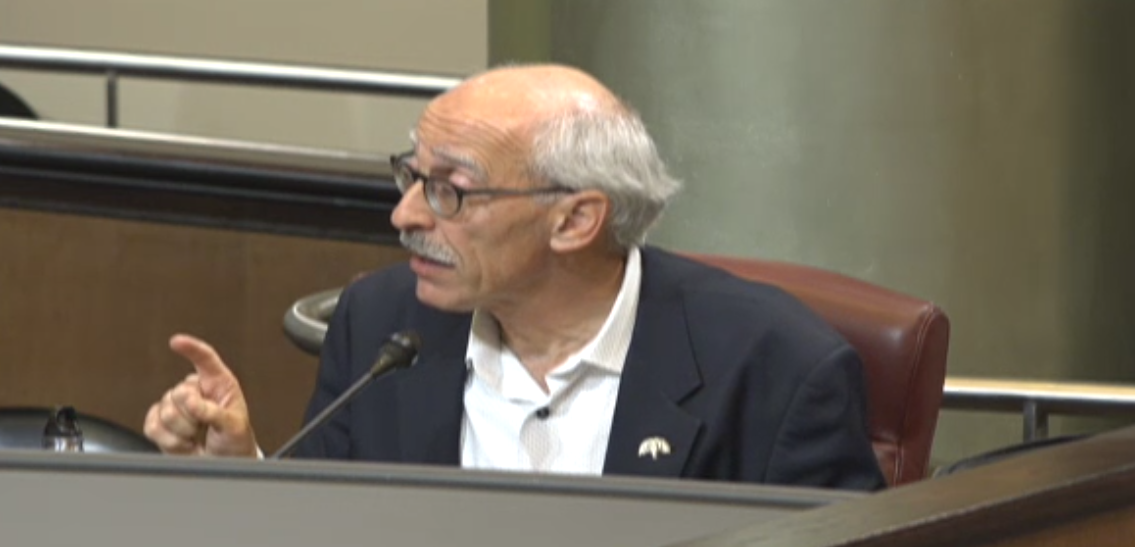
“Colleagues I don’t always ask a lot of you, but I do ask you to consider and support these ‘factual’ amendments,” Kalb said, appearing to make a personal appeal for his amendments.
Kalb argued that failing to condemn Hamas would send the message to Hamas to repeat their attack, ignoring the rationale posed by Fife. But Kalb's proposal went further than simply condemning Hamas for its October 7th attack—the text Kalb proposed would appear to leave the blame for all deaths on Hamas.
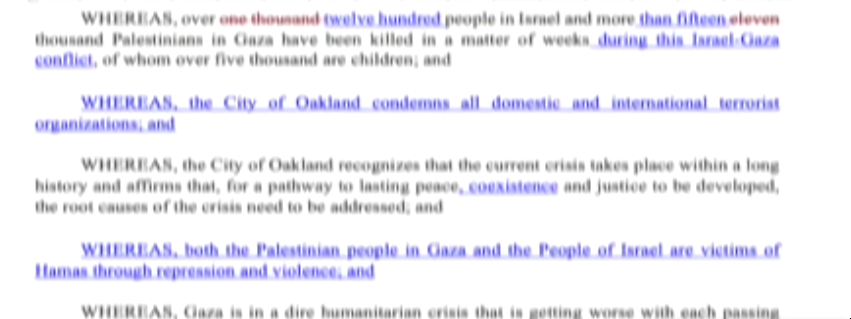
Council President Nikki Fortunato Bas, who nearly a month ago publicly promised advocates she would work to make a ceasefire resolution happen, specifically addressed Kalb’s amendments as unbalancing the proposal because they would ignore Israeli actions.
“The number of children that have been killed just since October 7th surpasses the number of children that have been killed in global conflicts over the past four years. And so there are many, many more facts that we would have to put into this resolution if we were going to add anything more to it,” Bas responded.
CM Janani Ramachandran agreed with both Bas and Fife that the resolution was balanced due to the omission of actors, the option that made most sense for a Council resolution.
“I support this resolution without amendments, because it is broad on the call to justice and cessation of violence. It does not mention the names of actors in this conflict, neither the Israeli government nor Hamas, and this is a conscious choice,” Ramachandran said via teleconference.
CM Treva Reid was the only lifeline for Kalb’s changes, adding that though she actually was in support of the original legislation, she would second Kalb’s motion out of solidarity."
“I do support the resolution as it is, and I also support my council colleague in hearing his voice ...although there were certainly some things I would amend in what he shared, I won’t have you stand alone in this moment, either, and I will second your amendments,” Reid said, apparently addressing her comments directly to Kalb.
The amendments received no other support in the vote for the substitute motion for Kalb’s legislation instead of Fife’s—substitute motions, according to Council rules of procedure, occur before the vote for the original legislation. Both CMs Kevin Jenkins and Noel Gallo had already expressed their desire for a ceasefire due to the tremendous loss of life in Gaza, but did not speak on Kalb's motion. Gallo specifically noted the bereavement of a resident of his district who had spoken about the killing of his family members by the Israeli attack in his very brief statement. Kalb’s amended legislation failed 6 to 2.
After Kalb’s vote failed, the original legislation passed unanimously with minor revisions for accuracy [4,000 additional Palestinians have been killed since Fife began writing the text, for example], with Kalb himself saying he supported it as it lacked criticism or condemnation of Israel and had removed any “hot button” language. Ironically, Kalb’s rationale for voting for Fife's original resolution bolstered her argument for excluding condemnations in the first place.
JCRC-BA Smear Campaign
A smear campaign initiated by the JCRC and aided by other organizations and social media personalities has proliferated in the days after the resolution, despite bearing little relation to reality.
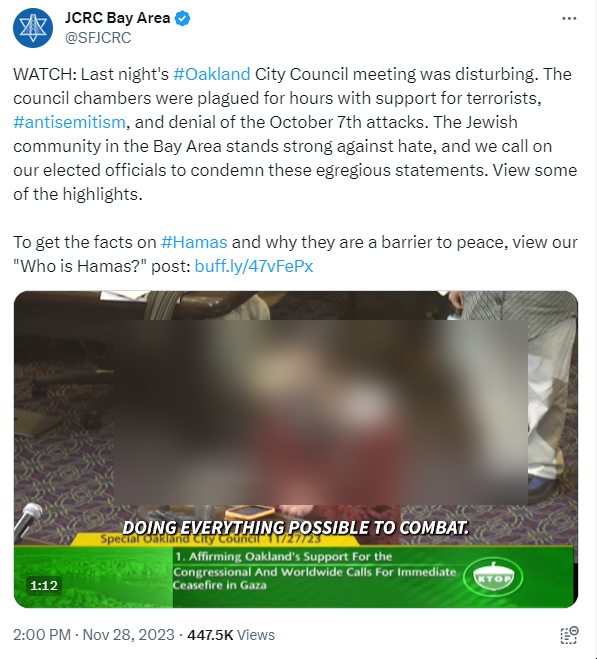
JCRC posted a 1 minute montage of nine speakers, after an initial post that garnered few views or attention, the video was circulated by influencers such as Yashar Ali and became viral. The splices are clearly taken out of context and bear no relationship to the full context of the meeting or even the full comments themselves—as shown with the full transcript of the comments, the video record of the meeting, dozens of witnesses and live reporting done by this publication captured on Twitter [X]. Democratic Party politicians who have remained silent about a ceasefire have used the video to lend themselves cover for their resistance, as Israel resumed its attacks on Gaza at the end of the temporary ceasefire, killing hundreds per day just days after the resolution passed.

Since JCRC’s action, and the virality caused by the propagation by large media accounts like those of Ali, this publication has learned that individuals in the video have been “doxed”—according to several sources some individuals have received a torrent of hateful emails sent to their employers seeking their termination.
JCRC director Gregory specifically maligned Arab Resource and Organizing Center [AROC] as a “pro-terrorist” organization to media sources the day after the meeting. AROC has sent a letter to Council and Mayor vocally calling out the behavior of Gregory and his organization as endangering Muslims during a time of heightened violence.
We will not be silenced & we will not allow our communities to be bullied by racists. We will not lose any more of our neighbors and loved ones.
— AROC #FreePalestine (@AROCBayArea) December 1, 2023
We welcome your solidarity at this difficult time. (6/6) pic.twitter.com/saAmNZkSSA
Ceasefire advocates now aim to support and call for a similar resolution at the San Francisco Board of Supervisors meeting on Tuesday.
*given the attacks triggered by JCRC’s video, this publication has chosen not to provide names of speakers in this report for their safety. The public video record is available here, however.
Also:
OPD Will Have Same Number of Officers After Academy Graduation This Week as at Commencement
At a Police Commission meeting Thursday, Interim Police Chief Darren Allison confirmed that the number of current police is 702, with 63 additional officers on leave. An academy that graduates next week will add 22 new police officers, according to Allison, bringing the current number to 724 a net increase of 0 officers from the number that existed when the academy began in June. The class had 30 recruits when it began, lower than in the past academies, and is one of OPD's historically lowest graduating classes. The next academy class in early December is projected to start with only 21 trainees, likely graduating even fewer officers several months from now.
Finance Director Confirms First Quarter Projection: Oakland Could be Facing a $129 MM Deficit by FY’s 23-24 End
At a Finance Committee Tuesday, Finance Director Erin Roseman confirmed to committee members that per a first quarter projection, the City is potentially facing a $129 MM deficit—with costs about $15 MM higher than expected, and revenues over $100 MM lower than expected. The higher costs are almost exclusively driven by a currently projected deficit of $32 MM in the OPD, offset to some degree from city-wide vacancy savings in other departments.
Despite having record low staffing, the police budget, after overages, may likely be one of Oakland’s highest. The City’s low revenue projections are driven by lower than normal predicted real estate transfer tax [RETT] revenue as the market winds down—Budget Director Bradley Johnson noted that the market had begun to cool down in the late in the last budget year, but the City’s ransomware issues delayed a full accounting of receipts.
ALPR Flock Camera System Months from Activation
A City of Oakland Public Information Office confirmed that the City’s installation of 300 Flock cameras at various sites in Oakland has not yet begun. After unanimous Council passage of the ALPR system use policy and funding in October, the final contract for the Flock branded system is still being finalized a spokesperson told this publication.
The first 200 cameras will be placed on pre-existing structures. Those could be installed by the end of the year, allowing the system to go live soon after. The remaining 100 placements will require creating the structures from scratch and won't be in place until next year. More on this story as it develops.
What’s At Council This Week
A look at notable legislation on Tuesday’s agenda...
Environmental Democracy Project Settlement Would Require Changes to Oakland Cannabis Industry Laws
A lawsuit settlement with Environmental Democracy Project, a local organization, apparently will require specific city protocols for cannabis industry activity, according to the legislation approving the settlement. Detailed legislative reports are not usually included with settlement legislation, so no further information is available at this time.
The suit against the City of Oakland and two cannabis industry companies and alleges environmental hazards and damages as a result of cannabis industry activities and the City of Oakland’s rules on cannabis cultivation and processing. In settling the suit, the City of Oakland must agree to bring to Council within a year of the settlement amendments to its ordinances that:
—Provide the public with notice of all cannabis cultivation permit
approvals
—Allow members of the public to administratively appeal cannabis
cultivation permits that would result in a cumulative total of at least
20,000 square feet of indoor cultivation at one parcel or address
—Require applicants for at least 20,000 square feet of indoor cultivation to
obtain confirmation from PG&E that it can handle the applicant’s load
using PG&E protocols for load studies
—Require cannabis cultivation applicants to obtain all legally required
permits, including building, fire, and State cannabis permits
—Require City staff to periodically inspect cannabis growth operations at
least once a year
—Require applicants for more than 20,000 cumulative square feet of growth to identify other such operators within 300 feet, and for the City to evaluate whether such other operators may result in certain cumulative impacts
—Prohibit indoor cannabis operations within 600 feet of any schools or residential live-work uses
—-Ban the use of fossil fuel generators for indoor cultivation (which the City already bans)
—The City must adopt express guidelines governing how it will exercise its discretion in taking enforcement actions for indoor cultivators who violate their permits or City ordinances
OPD Aircraft Mounted Camera (AMC) Use Policy
OPD has been seeking to add fixed wing aircraft [FWA] to its stable of vehicles since the beginning of 2023, with ample support from Council. The move has followed repeated conflicts over the cost of repairing and servicing Oakland’s aging helicopter fleet. OPD has argued that FWA will be more eco-friendly, cheaper and less intrusive to community skies.
While it still remains to be seen whether the aircraft will result in a real reduction of helicopter ownership and use, the FWA brings up other issues—a new surveillance system, for one. The Aircraft Mounted Camera [AMC] is required for the FWS to be of any use for police, given the fact that higher altitudes will no longer allow for unaided human vision to view on the ground activity. The Oakland Privacy Advisory Commission [PAC] reviewed and approved OPD’s use policy in September, and the use policy now comes before council for the legally required approval necessary to purchase the system. Without this approval, the OPD could not move forward on purchasing FWA.
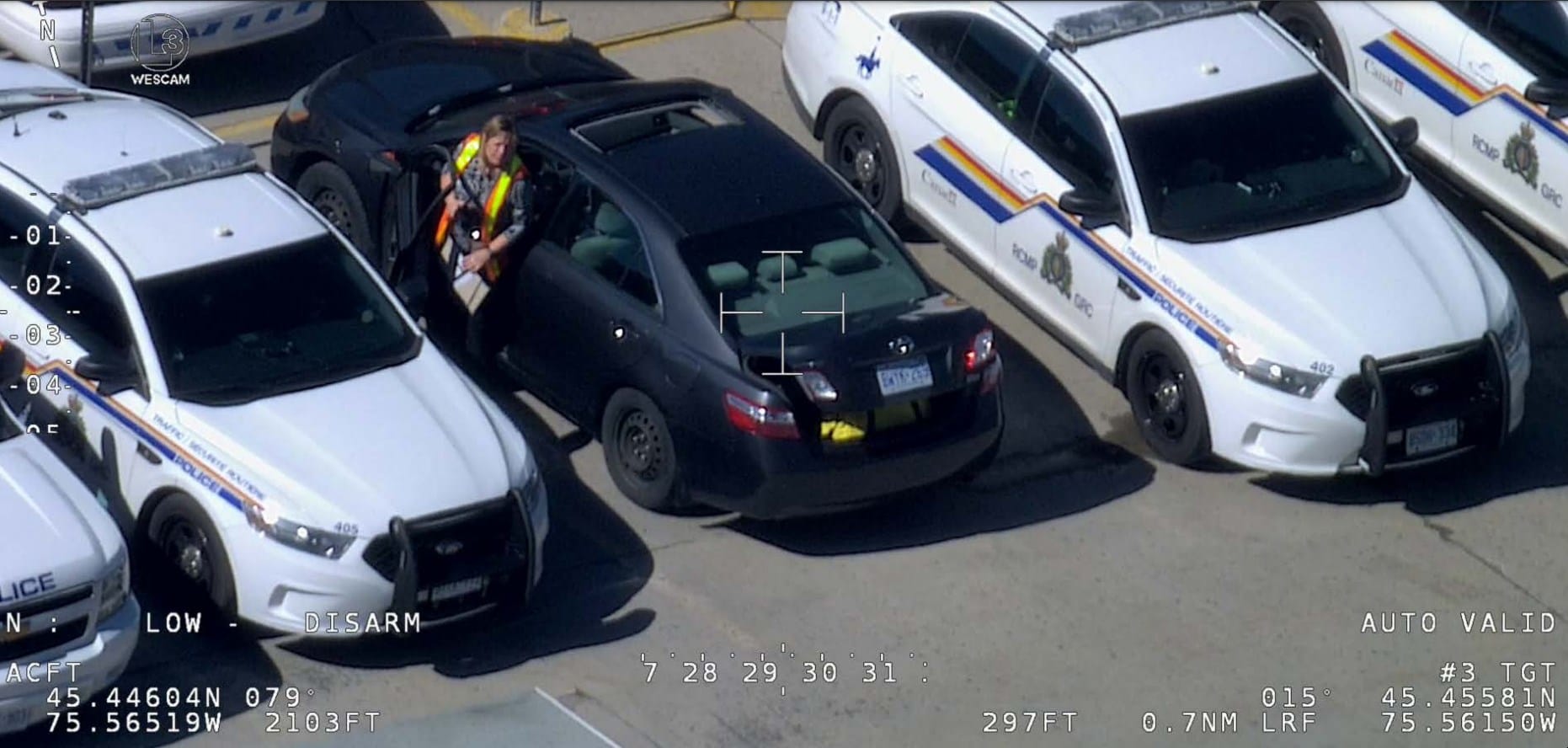
The AMC is a Wescam surveillance system with advanced features, including infrared and magnification—in sample photos provided to the body and PAC, camera images appear to clearly show human faces from distances of thousands of feet. The Wescam system engages on take off, and is always recording in a self-deleting loop until activated for recording. The use policy also includes a specialized hand-held ground unit that can receive the feed through a secured signal and will allow, according to the report, direct access while policing “1st amendment activities” like protests and demonstrations.
Safe Work Zone Ordinance
The oddly-crafted "Safe Work Zone" legislation first appeared before the Public Works Committee late last year when the Committee was composed of Noel Gallo, Loren Taylor, Dan Kalb and current Mayor Sheng Thao. With Thao absent and Kalb abstaining, Gallo and Taylor sent the legislation onward to Council with little discussion. The legislation was opposed by a wide-ranging coalition of legal advocates and homeless services organizations—ACLU, Bay Area Legal Aid, National Lawyers Guild, and East Bay Community Law Center, among others. Arianna Casanova, an organizer with SEIU 1021, the union that would be most affected by the law, called in to the December meeting to oppose the legislation, arguing that it was duplicative and an excuse not to make spaces safe using existing resources and laws.
But the legislation from the Department of Public Works was caught up at Rules, where, with Bas presiding, questions were brought up about the legality and potential for duplication of existing laws and city practices.
The Rules committee withdrew the item and asked DPW to come back with a better rationale for the new legal construct. But the item did not return to Rules until almost a year later, on November 9th of this year. At that meeting, Assistant City Administrator Joe Devries argued that the item having already been forwarded from committee should simply be scheduled directly to Council. Bas was absent from the meeting, and Kalb presided as Chair—the legislation was forwarded directly to Council’s consent agenda by a majority vote.
Despite direct scheduling with minimal discussion, the legislation is now more expansive and includes any contractor, city-hired or not, working on “essential infrastructure”—workers and sites for companies like EBMUD, PG&E, Comcast and AT&T.
In arguing for an expanded scope, the new legislative report from DPW presents PG&E claims of increases in “workplace violence” and unspecified work site issues since 2022. But the majority of the “violence” described in the new report is described as “hostile behavior” and “threats” not actual physical violence, which appear to be low over a period of five years. The data is not disaggregated, and does not have a source listed, i.e, police reports vs PG&E’s own complaint system.

The new legislation would give police clear guidance to arrest anyone who disregards a police command to leave the “safe work zone” as demarcated according to the ordinance in the area of workers. The geographic area of the zone itself is not defined, with only limitation it be "no larger than is reasonably necessary for Protected Workers to carry out their duties based on the size and type of equipment and the scope of the work..."
The legislation now also appears to specifically limit both freedom of the press and protest activity to areas outside whatever safe zone is demarcated. During the eviction of the large Wood St encampment, press were often kept far from the activity of the demolition and removal of structures, with the claim that the distance was required for the work, as is clear from the following account from journalist Caron Creighton.
Rounding out my 12 hr day at Wood St. I got here around 5am and leaving at 5:30. Had to stick around all day because if I leave, there's a possibility I could be refused access if I return. The city has had continually changing rules that have made reporting very challenging.
— 📸 caron (@caroncreighton) April 29, 2023
Creighton, who frequently covers homeless issues—including evictions—has expressed concern about how the legislation could affect reporters' access to evictions and the rights of homeless residents in work areas. Creighton made the following statement to the Oakland Observer:
“It's ironic that this proposed ordinance mentions protecting 1st Amendment rights, as it would violate Oaklanders 1st Amendment rights.
As a journalist who covers unhoused communities, this ordinance would make it very challenging, if not impossible, to do my job. I'm one of the few journalists who covered the Wood Street eviction in April, where the city of Oakland tried to prevent press access. Wood Street residents and journalists brought a lawsuit, and the city was forced to change their policies.
As a video journalist, it's important to be allowed close access to sweeps so I can actually see and hear what’s happening. If a “safe zone” were to be established, it would likely create so much distance between myself and unhoused community members that it would be impossible to film anything of consequence. I've built relationships with unhoused people at encampments across Oakland. People have even asked me to film at sweeps, to show what evictions are like. When journalists aren't present, advocates and legal observers fill a similar role, filming interactions between encampment residents and city workers. These recordings are essential to keep the city accountable, in a situation with an incredibly skewed power dynamic.
I agree that people should be safe at work. They should also be safe in their homes– no matter what those homes look like. I ask you as a journalist and an Oakland resident, please vote no on this ordinance.”
Montclair BID Annual Report and levy approval and Rockridge annual BID report.
The Oakland Observer has not reviewed these reports, but should be interesting to those who follow BIDs.
Amendments to Rent ordinance and Rent Adjustment Program Regulations
This legislation would make numerous changes to City of Oakland rent ordinance and Rent Adjustment Program rules, the most salient being removing restrictions that require tenants to be up to date with rent before responding to a Rent Adjustment Board petition—staff argues that the city’s rent ordinance does not cover payments, and Oakland is the only City that has such a requirement. Some other changes:

Increased Spending Authority for City Security Contractor
The City Administrator will ask for increased spending authority for security services per month to cover the overlapping transition of a new security contractor that will begin in 2024. The City says it will otherwise run out of money to pay for security for various city sites, including City Hall and Frank Ogawa Plaza. By the end of the contract, the City will have spent $18 MM on security since 2018.
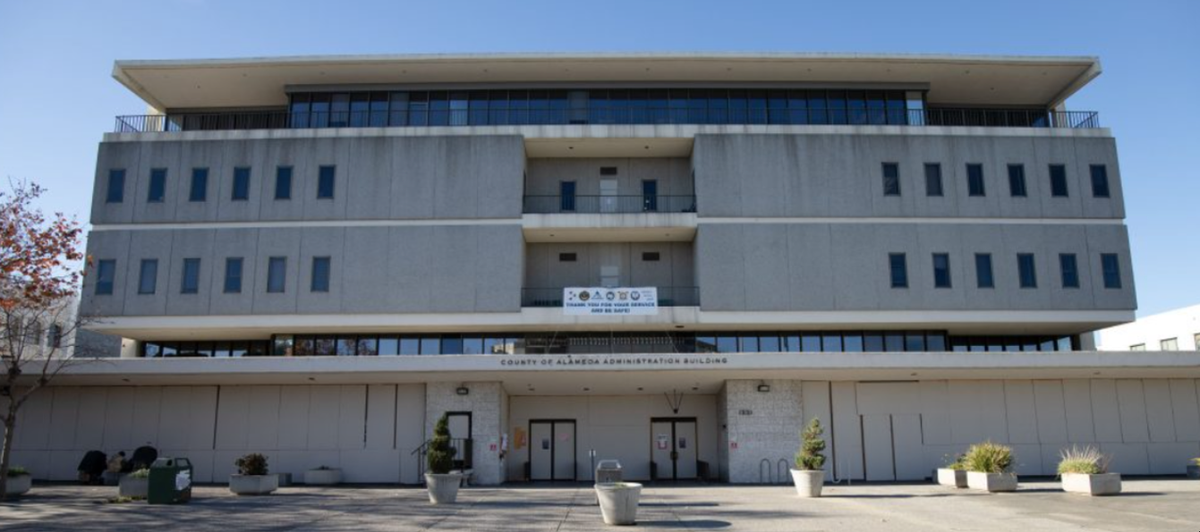
Comments ()